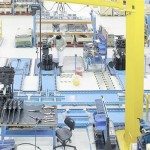Replacing Constant Speed With Variable Speed
In the past, applications operating at less than 300 rpm, and rated from 500 kW to 5000 kW, have been controlled using a medium-voltage constant speed synchronous motors. Common applications include crushers and various mills used in metals, cement or mining. Replacing a constant speed with variable speed drive control brings substantial operating and maintenance improvements. Variable-speed drives provide soft starting, precise speed and torque control and low stress on the electrical network. Soft starting lets the motor get up to speed gradually, thereby avoiding high inrush currents that can prevail when direct-online starting is used. As such, the stress on the motor and all components in the transmission train are much reduced. This avoids failure of key components while reducing maintenance costs and prolonging motor and transmission life time.
ABB industrial drives feature the motor control platform, and direct torque control (DTC). DTC provides the highly accurate speed and torque control often needed in slow speed applications. With a power factor approaching unity, the variable-speed drive has low reactive power consumption; thereby lowering voltage variations on the supply network. The variable speed drive and motor can be connected to weaker supply networks without the need for power factor correction equipment. An advantage of using new synchronous motors with ABB industrial drives is that, for most cases, the existing foundations can be re-used. A key benefit of variable-speed control is that the new motor has fewer pole pairs and a smaller shaft height. This is because a constant speed synchronous motor needs to be designed for its maximum speed. So a 2500 kW motor requiring 150 rpm has 40 poles and typically a shaft height of 2000 mm. However, using variable-speed drive, the motor has between 8 to 24 poles and a typical shaft height between 1250 to 1600 mm. This substantially lowers the motor costs and even when the drive and transformer are considered, the investment will be less expensive than a 40-pole motor.
Benefits Of Replacing Constant Speed With Variable Speed:
- Soft starting capability reduces stress on motor and transmission train
- Optimum speed according to process requirements
- Lower maintenance costs and prolonged motor life
- Low stress on the electrical network through unity power factor and low reactive power consumption
- Choice of smaller traditional synchronous motor
- No need to alter foundations thereby avoiding any loss of production and costly civil works
- Typically lower total cost than a new constant speed synchronous motor
To learn more about replacing constant speed with variable speed, or for variable speed drive repair and replacement quotes, contact Precision Electric, Inc.








